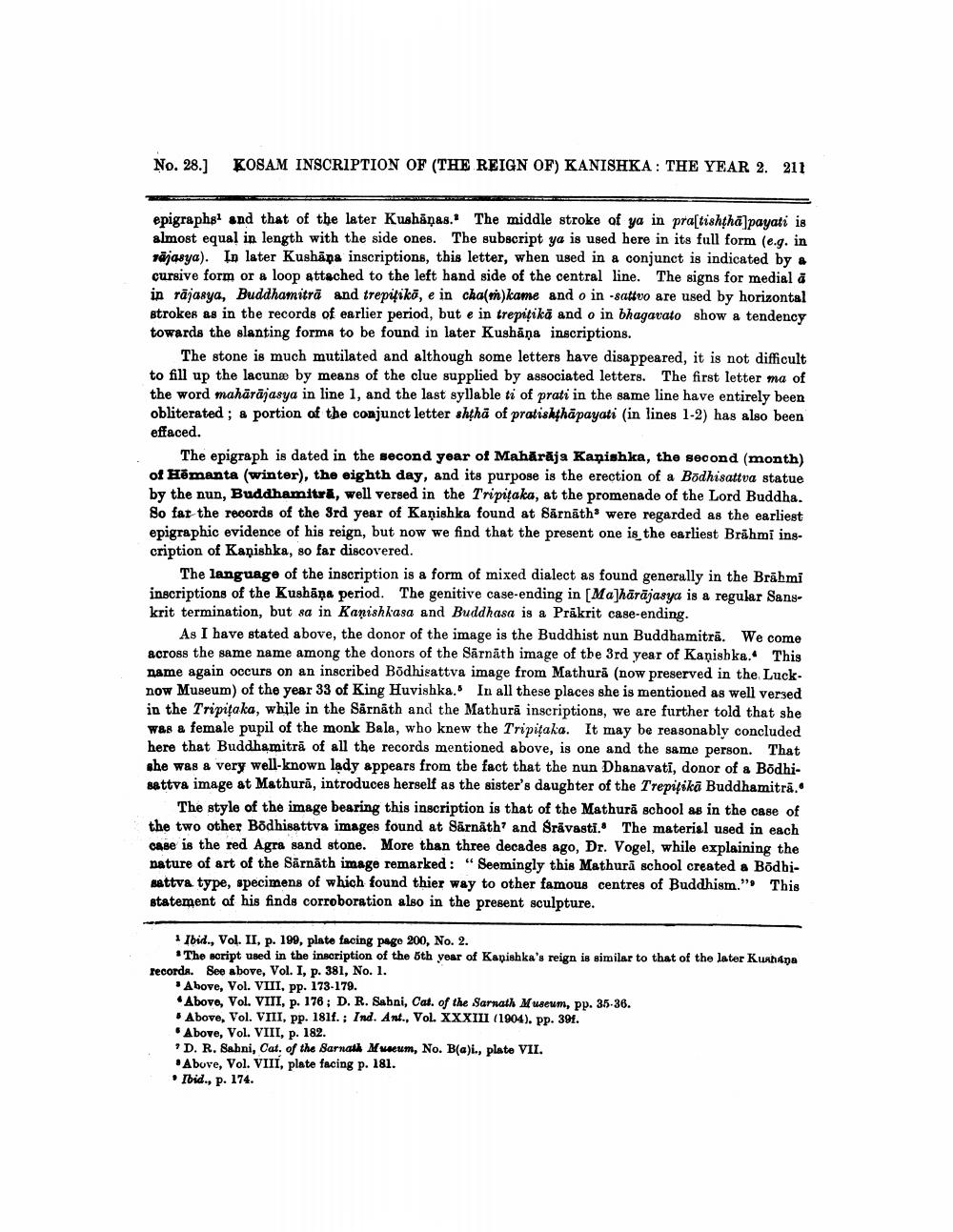________________
No. 28.]
KOSAM INSCRIPTION OF (THE REIGN OF) KANISHKA: THE YEAR 2. 211
epigraphs and that of the later Kushanas. The middle stroke of ya in pratishtha payati is almost equal in length with the side ones. The subscript ya is used here in its full form (e.g. in rajasya). In later Kushana inscriptions, this letter, when used in a conjunct is indicated by a cursive form or a loop attached to the left hand side of the central line. The signs for medial a in rajasya, Buddhamitra and trepitiko, e in cha(m)kame and o in -sattvo are used by horizontal strokes as in the records of earlier period, but e in trepitika and o in bhagavato show a tendency towards the slanting forms to be found in later Kushāņa inscriptions.
The stone is much mutilated and although some letters have disappeared, it is not difficult to fill up the lacunæ by means of the clue supplied by associated letters. The first letter ma of the word maharajasya in line 1, and the last syllable ti of prati in the same line have entirely been obliterated; a portion of the conjunct letter shtha of pratishthapayati (in lines 1-2) has also been effaced.
The epigraph is dated in the second year of Mahārāja Kanishka, the second (month) of Hemanta (winter), the eighth day, and its purpose is the erection of a Bodhisattva statue by the nun, Buddhamitra, well versed in the Tripitaka, at the promenade of the Lord Buddha. So far the records of the 3rd year of Kanishka found at Särnäths were regarded as the earliest epigraphic evidence of his reign, but now we find that the present one is the earliest Brahmi inscription of Kanishka, so far discovered.
The language of the inscription is a form of mixed dialect as found generally in the Brahmi inscriptions of the Kushana period. The genitive case-ending in [Ma]hārājasya is a regular Sanskrit termination, but sa in Kanishkasa and Buddhasa is a Prakrit case-ending.
As I have stated above, the donor of the image is the Buddhist nun Buddhamitra. We come across the same name among the donors of the Sarnath image of the 3rd year of Kanishka. This name again occurs on an inscribed Bodhisattva image from Mathura (now preserved in the Lucknow Museum) of the year 33 of King Huvishka. In all these places she is mentioned as well versed in the Tripitaka, while in the Sarnath and the Mathura inscriptions, we are further told that she was a female pupil of the monk Bala, who knew the Tripitaka. It may be reasonably concluded here that Buddhamitra of all the records mentioned above, is one and the same person. That she was a very well-known lady appears from the fact that the nun Dhanavati, donor of a Bōdhisattva image at Mathura, introduces herself as the sister's daughter of the Trepitika Buddhamitra.
The style of the image bearing this inscription is that of the Mathura school as in the case of the two other Bodhisattva images found at Särnäth' and Srävasti. The material used in each case is the red Agra sand stone. More than three decades ago, Dr. Vogel, while explaining the nature of art of the Sarnath image remarked: "Seemingly this Mathura school created a Bōdhisattva type, specimens of which found thier way to other famous centres of Buddhism." statement of his finds corroboration also in the present sculpture.
This
1 Ibid., Vol. II, p. 199, plate facing page 200, No. 2.
The script used in the inscription of the 5th year of Kanishka's reign is similar to that of the later Kushana records. See above, Vol. I, p. 381, No. 1.
Above, Vol. VIII, pp. 173-179.
Above, Vol. VIII, p. 176; D. R. Sahni, Cat. of the Sarnath Museum, pp. 35-36.
Above, Vol. VIII, pp. 181f.; Ind. Ant., Vol. XXXIII (1904). pp. 39f.
Above, Vol. VIII, p. 182.
"D. R. Sahni, Cat. of the Sarnath Museum, No. B(a)i., plate VII. Above, Vol. VIII, plate facing p. 181.
⚫ Ibid., p. 174.




